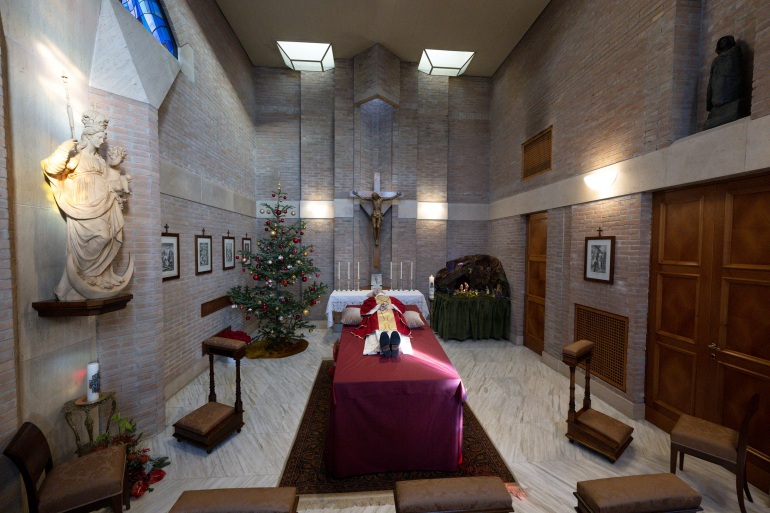[ad_1]
Thousands are expected to pay their last respects to the former pope, whose body will lie in state for three days.
Tens of thousands of visitors are expected to pay their last respects in the Vatican to former Pope Benedict XVI, whose body is lying in state for three days starting Monday at St Peter’s Basilica before his funeral.
The German theologian, who died on Saturday aged 95, led the Catholic Church for eight years before becoming the first pope in six centuries to step down in 2013.
His successor Pope Francis will lead the funeral on Thursday in the vast St Peter’s Square before his remains are laid to rest in the tombs beneath St Peter’s Basilica.
Benedict died at the Mater Ecclesiae monastery inside the Vatican gardens, which had been his home for the past decade.
On Monday, his body will be transferred to the basilica where, for three days during the daytime, the faithful will be able to say goodbye.
The Vatican on Sunday released photos of his corpse, dressed in red papal mourning robes and wearing a gold-edged mitre on his head, on a catafalque in the monastery chapel.

Benedict’s shock resignation created the extraordinary situation of having two “men in white” – him and Francis – at the Vatican. He cited his frailty, saying he lacked the strength for such a demanding job. His resignation may have ultimately paved the way for Pope Francis and future pontiffs to resign due to poor health.
His funeral will also break new ground.
Papal deaths usually trigger the calling of a conclave of cardinals to elect a successor, but this time Francis remains in post, and will lead proceedings.
Benedict’s funeral will be “solemn but simple”, the Vatican has said, after which he will be buried in the papal tombs under St Peter’s Basilica. The Vatican has yet to release details of the guest list, beyond saying that it will include delegations from Italy and Benedict’s native Germany.
The last papal funeral, of John Paul II in 2005, drew a million faithful and heads of state from around the world, although Benedict was a more divisive figure.
A brilliant theologian, he alienated many Catholics with his staunch defence of traditional values. As pope, he struggled to impose his authority on the church as it battled a string of crises, including over clerical sex abuse. His successor cuts a very different figure, an Argentinian Jesuit who is most at home among his flock and has sought to forge a more compassionate church.
Pope Francis paid tribute to Benedict in three New Year’s events at the Vatican over the weekend, “thanking God for the gift of this faithful servant of the Gospel and of the Church”.
Francis, 86, has raised the prospect that he might follow Benedict’s example and step down if he became unable to carry out his duties.
In July, suffering knee problems that have forced him to rely on a wheelchair, he admitted he needed to slow down or think about stepping aside.
Last month, Francis revealed he had signed a resignation letter when he took office should poor health prevent him from carrying out his duties.

